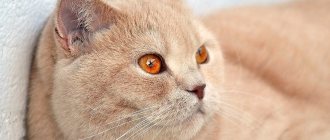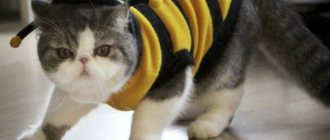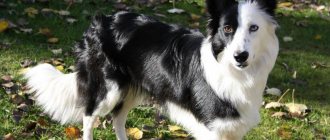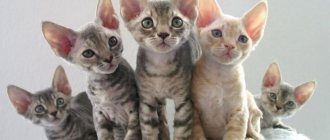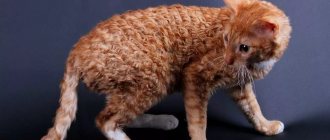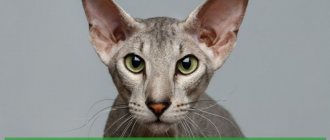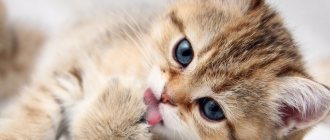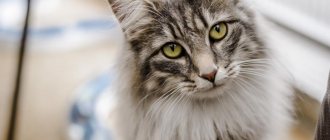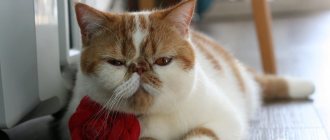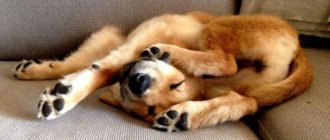A cat is a proud, independent animal, tamed by man, who has become his friend and family pet. A domestic cat is a member of the family for many years, and after a period of “breaking in”, it knows the owner’s character well. The four-legged pet is considered the most popular among other pets. A cat not only brings joy to a person’s life, but also hunts rodents.
Physical training
Jump
Cats are famous athletes. If nature wanted to create an ideal hunter, then it would certainly be cats. Well-built, flexible and graceful creatures, capable of real stunt tricks:
- Everyone knows about a cat's ability to land safely when falling from a height. An animal can twist in the air so as to fall on its paws and not be damaged even from a height of several floors. Curving in flight, the murka turns first its head, then its back and legs, almost at lightning speed, jumping straight to its feet. Moreover, the higher the height, the greater the chances of completing the landing successfully;
- Cats love heights. Thanks to their phenomenal sense of balance and excellent coordination, they become virtually invulnerable when climbing trees;
- The musculoskeletal system of the Murka has 250 bones and 517 muscles, and 10% of all bones are in the tail, which allows for excellent balance when running;
- Cats have fantastic vision. At a distance of sixty meters, the furry huntress is able to discern the slightest movement of the smallest rodent. Despite the fact that they don’t care about details. This explains the attempts of pets to catch a barely noticeable shadow or their own tail;
- Murki's sense of smell is 14 times greater than that of humans. And in addition to the nose, the “Jacobson’s organ” located on the palate helps the cat smell;
- A domestic cat can reach speeds of up to 48 km per hour, which exceeds the “human” record by as much as 5 km per hour;
- Murks are true hunters. Stray cats have caused the extinction of 33 animal species.
Types of cats: description
Such pets may have long fur.
According to statistics, the domestic cat species makes up the majority of all its relatives (the population is about 90%), in contrast to purebred specimens (they make up only 2-10%). The name allows us to summarize all varieties of pets that do not fit the scientific description of breeds. An ordinary cat is classified by length, type and color of coat, and size. There are long-haired and short-haired, curly and hairless, large and dwarf. The shape and length of the tail and ears are important: tailless (Manx) and bobtails.
The description of a cat depends on its habitat. Thus, the northern varieties are large, muscular, with thick hair. Southern mongrel cats are short-haired, without undercoat, graceful and graceful. Inhabitants of western latitudes can boast of a natural blue tint of fur, but the characteristics of color variations often come down to brindle, red, 2 or 3 colors. The scientific community has not been able to reach a consensus on the origin, classification and abundance of the species.
Relationships with people
Scientists believe that the domestication of cats occurred more than three thousand years ago. The Egyptians were the first to allow cats into their homes. And the ancients can be understood: the animal not only perfectly guarded food warehouses, but also rose to the rank of a deity. But it is difficult to understand a cat: it is still not clear why an independent, freedom-loving animal needed to live under the same roof with a person. Perhaps the Murkas needed universal adoration? A lot of arguments can be given in favor of this version:
- Cats have an excellent sense of intonation in the human voice. When addressing your pet harshly, remember that he will definitely feel it. But a sense of self-superiority will not allow the cat to either admit or agree with your opinion.
Murki meow only “for people.” In the company of cats, furry ones use other sounds. For unintelligent people, animals “invented” hundreds of variants of “meow”, naively believing that a person distinguishes the meaning of each of them.
- The tail serves as a kind of mood indicator. Raised vertically and slightly quivering means the cat is happy to see you. Lifelessly drooping, most likely, indicates the Murka’s reluctance to have anything to do with you. If a pet swings its tail from side to side, then it is probably deciding on something: to enter the room or not to enter, to eat or sleep. Agree, this is a matter of utmost importance.
- Cats don't always rub against humans out of friendliness. Most often, the musk smells a foreign scent on “its” person and, with the help of its scent, tries to kill someone else’s. The same explains the habit of tailed animals to sleep on clothes and new things.
- Licking belongs to the same category of gestures. If the cat begins to actively “look after” you, most likely she considers you a representative of her “herd”. And you should smell like her and generally urgently need tenderness.
- A cat tramples its owner's stomach - there is a reason for pride. The person has pleased the pet in all its whims and can calmly enjoy the neighborhood. If the cat also nudged you with its forehead, rejoice, you’ve hit a real jackpot of furry emotions.
- Cats act as a sedative. In families where furry animals live, there are fewer quarrels and significantly lower stress levels.
- Most house murkas bury traces of their vital activity. But if the animal does not try to hide its “deeds,” it tells the person: “I am not afraid of you.” This is in some way a sign of aggression or competition.
What to feed?
Cats have well-developed taste buds on their tongue. They distinguish between sour, salty, bitter and sweet.
The food tract of cats is accustomed to meat. Sharp fangs crush it, and the tubercles on the sides of the tongue help separate the pulp from the bones. The meat menu needs to be diversified with other high protein foods - fish, eggs, dairy products. Carbohydrates are needed in small quantities - cereals, vegetables, bread. Eating too much food leads to obesity, and a normal human diet is harmful to a cat. Periodically, the cat's stomach is cleared of undigested residues. To do this, the mustache “snacks” on grass, leaves, and at home – on house plants, for example, aloe. Sometimes the “hunter” eats soil, which indicates a lack of microelements. They are always included in cat food.
Interesting facts about cats
Mouser
- In the Middle Ages, Europe was struck by a plague epidemic. One of the reasons for the spread of the disease was the mass extermination of the cat tribe and, as a consequence, an increase in the population of rats - carriers of the plague.
- In Britain, cats guard food warehouses, for which they receive payment in the form of food, and also after a few years they go into “retirement”. One furry guard annually saves about ten tons of grain.
- Cats allow themselves to sleep for 70% of their lives.
- Among furries, there are right-handers and left-handers. The former are more common among girls, and the latter among boys.
- A cat can give birth to about a hundred kittens over the course of its life.
- The Egyptians idolized cats so much that if a pet died, they shaved off their eyebrows as a sign of mourning.
- Men who have a cat in their house are considered luckier in their personal lives.
- Excessive love for cats is quite common and has even received a name - ailurophilia.
- Cats are inferior to dogs in terms of intelligence, but are capable of performing more complex tasks. The only condition for this is the cat’s personal interest in the matter.
- Most owners (95%) admit that they talk to their pets, every fifth cat is blow-dried after bathing, and every third owner is sure that their pet reads their thoughts.
- A black cat does not always portend trouble. In Britain and Australia, such an animal is associated with great luck.
- If the cat is unsure whether it will fit through the hole, it will use its whiskers to explore the area.
- When bringing dead mice into the house, the cat does not try to feed the owner. He tries to teach him to hunt and eat properly.
- Most purrs are not that afraid of water. They can easily go into the water and fish. Home bathing frightens pets only because they are forced into a basin.
- Cats hide when they are sick. A weakened body becomes easy prey for enemies, so the animal, feeling unwell, tries to take cover
Nibelung
Muscular and lean Nibelungs are a godsend for active people. They are active, affectionate and sociable. These cats gain up to 6 kg of weight (females - up to 4 kg), have a luxurious coat, and the cats are fluffier than males.
Photo: pixabay.com: UGC
Origin
Representatives of this breed are indirectly related to the “Song of the Nibelungs”. The first representatives received from the owners the names of the main characters of this saga. They were born in the early 1980s. in the USA as a result of crossing a long-haired yard cat with a Russian blue cat.
Appearance and character
The main feature of the Nibelung is its luxurious smoky coat and emerald eyes. These are smart and restrained cats in their displays of emotions. Their distinguishing feature is responsiveness. They become attached to one of the owners, pay attention to him, but do not get bored.
Care
Nibelungs need to be brushed regularly and bathed as needed using a special shampoo. Pay special attention to your pet’s teeth: brush and buy special food that will remove tartar.
Fluffy record holders
The longest cat Stewie
The Guinness Book of Records also contains interesting facts about cats:
- The longest-living record holder was the cat Creme Puff from Texas. He lived for 38 years. And the oldest cat lives in Australia. She was born in 1977.
- The most famous mousetrapper was the cat Towser, who lived at the whiskey factory. During his 21 years of service, the furry hunter killed more than 28,000 rodents. A monument was erected in honor of the faithful “servant”.
- The most well-fed cat is considered to be Himmy, who weighed 21 kilograms and, thanks to a waist measuring 84 centimeters, was included in the Book of Records.
- The longest cat in the world was, of course, the Maine Coon. Its length was 123.19 cm
- The most notorious traveler is the cat Hamlet, who escaped from his carrier during a flight. Seven weeks later, the fugitive was found in the cabin. The distance that the cat “flew” was about 600 thousand km.
- The record for the largest number of cats living in one house was set in Canada. The couple Jack and Donna kept 689 pets at the same time.
- A cat named Mincho has set one of the strangest records. She climbed up a tree and didn’t get down... for six years. Living at the top, the pussy managed to give birth to kittens three times.
- A fertility record was set in Africa: a Persian cat gave birth to 14 kittens. In 1970, there was a cat in Britain who also gave birth to 19 kittens, but only 14 of them survived.
- Today, Mr Peebles is considered the smallest cat, weighing 1.35 kg with a height of just over 15 cm.
Exotic (exotic shorthair)
Exotics have soft, plush fur and a flattened nose, which adds to their charm. These short-haired cats gain up to 7 kg in weight and grow up to 30 cm at the withers.
Photo: pixabay.com: UGC
Origin
The breed was selectively bred in the USA in the 1960s. Appeared as a result of crossing Persians and cats with short hair. The professionals were disappointed with the result, but the public liked the thick-footed cats with a sweet face.
Appearance and character
Exotics are distinguished by a massive body (wide chest and powerful paws), a flattened muzzle, huge, bulging eyes, stockiness and external clumsiness, plush fur. The color can be monochromatic, bicolor and tricolor.
Softness and pliability prevail in behavior. They love to play outdoor games, so small children are their passion. They are prone to depression and may refuse to eat if the owner has left somewhere.
Care
Be sure to take care of a separate sleeping place - a warm house or bed. Place them away from drafts. Perform standard hygiene procedures regularly and ensure that gingivitis does not develop.
Mythical cats
Since ancient times, cats have been considered attributes of magical rituals. They were also credited with supernatural powers.
In Spanish-Jewish mythology, there is a belief that Lilith, Adam's first wife, was reincarnated as a vampire. She took the form of a black cat and drank human blood from sleeping children. Since then, there has been a superstition that cats “suck out” children's souls.
In ancient China, cats were believed to have the ability to exorcise evil spirits. These animals also personified Yin energy, femininity and darkness.
In Egyptian mythology, the sun god Ra is often represented as a red cat who swims along the underground Nile every night, fighting a serpent.
In Christianity, cats are endowed with negative traits. They are considered the embodiment of evil spirits and assistants of Satan. Beliefs say that witches flock to the Sabbath in the form of black cats.
Muslim legend says that it was a cat that saved the Prophet Muhammad from a snake attack. As a sign of gratitude, he stroked the cat, and stripes remained on its back - color. The Prophet is often called the "father of cats." There is also a legend that one day a cat fell asleep on the edge of his clothes. When leaving, he cut off the hem of his robe so as not to wake up the sleeping woman with his departure.
In Rus', cats were known back in the 7th century. Ancient legends mention the Bayun Cat, endowed with the gift of putting the enemy to sleep, thus sending death to him.
How to choose the perfect cat
It will not be possible to choose an ideal, since each owner has his own idea of the ideal. For some, the most important thing is a kitten’s playfulness, for others – complaisance and learning ability.
The most important advice that can be given to a future pet owner is quite simple. You need to follow your inner instincts and choose a kitten that you like. Even if you make a mistake with your choice, your character can always be corrected by upbringing and showing care and love for the animal.
Cats of different breeds
The director of the pet salon, Natalya Khabarova, will talk about how to determine temperament and understand what kind of character a particular cat may have.
Chartreuse
A blue shorthair cat with unique behavioral skills is a treasure of France. Chartreuse wins hearts at first sight with its aristocratic manners and sophisticated appearance. Cats of this breed gain weight up to 9 kg with a height of 30 cm at the withers.
Photo: pixabay.com: UGC
Origin
In the 13th century, the breed was selected by the monks of the Catholic monastery of Grande Chartreuse. In 1928, the breed was officially registered. During the Nazi occupation of France, the Chartreuse was on the verge of extinction. After the war, the breed was restored.
Appearance and character
These are large cats with a trapezoidal head, round cheeks that form a smile - a distinctive feature of the Chartreux. The eyes are orange or yellow, the coat is blue, shimmering with silver. The nose is graphite, and the paw pads are gray-pink.
These cats are lazy. They love to lie down more than play. They tolerate loneliness well. They exhibit the habits of dogs: they can lie in front of the door for hours waiting for the owner. They rarely speak in a quiet voice, like a whisper.
Care
The breed is prone to obesity, so watch the diet and periodically arrange a diet. Pay special attention to the condition of your teeth. Chartreuse's gums often become inflamed.
